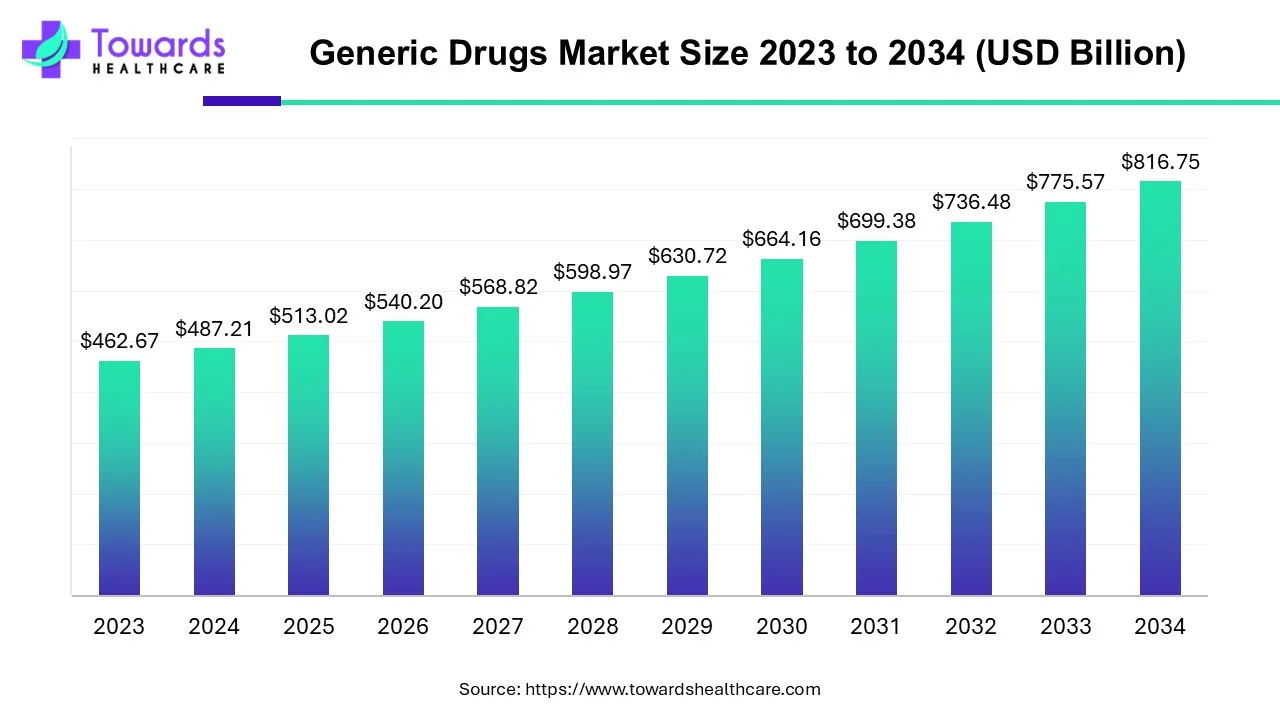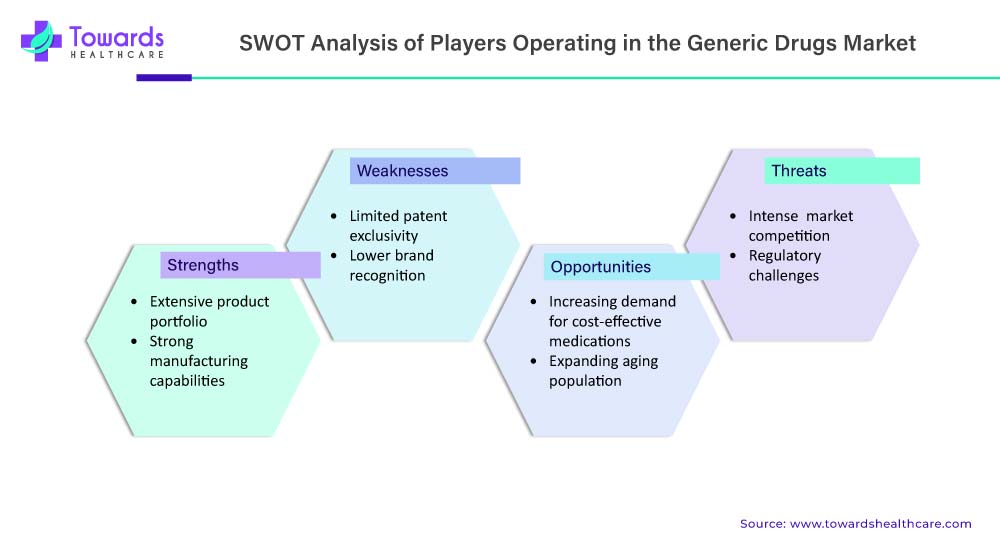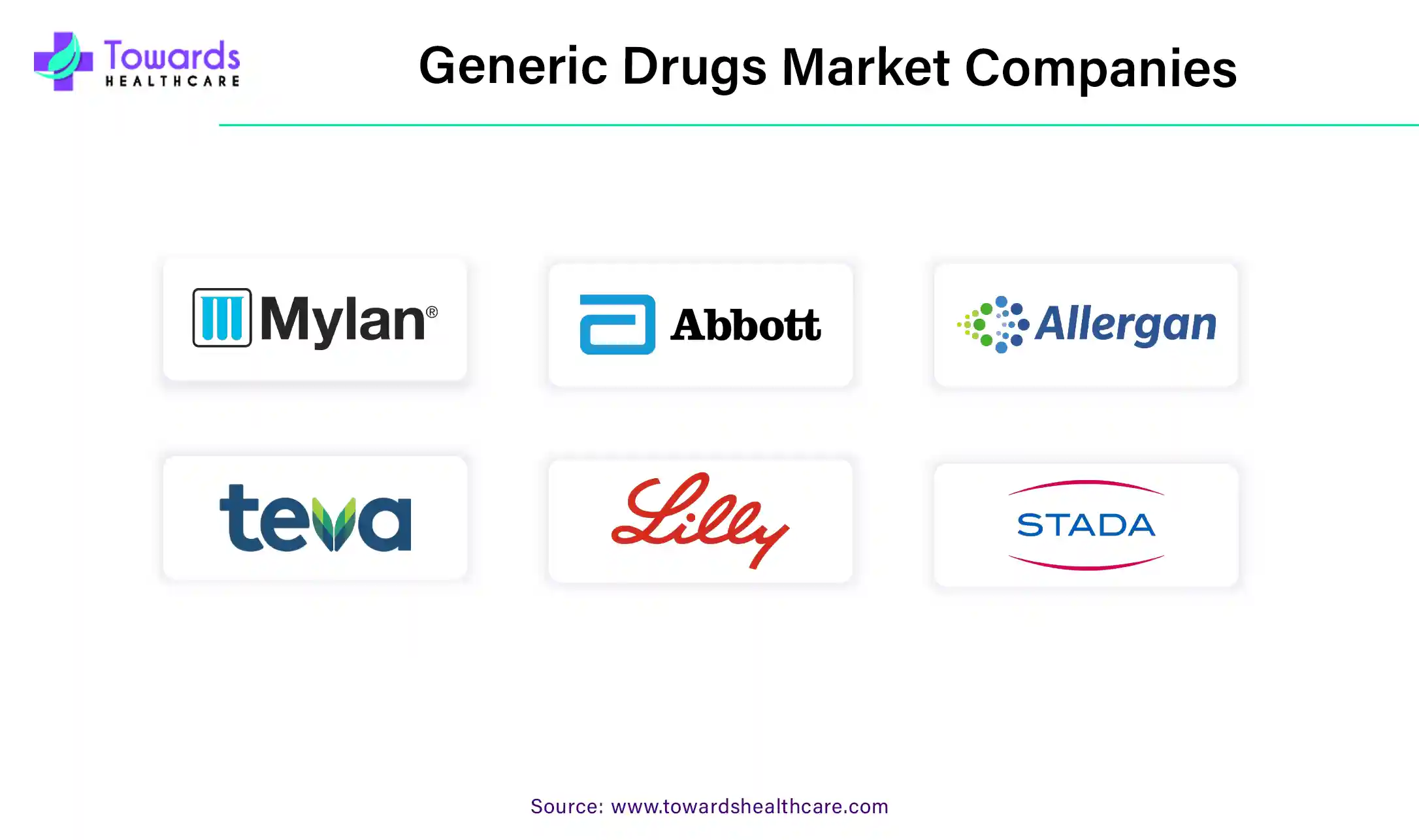January 2026

The global generic drugs market size is projected to reach USD 859.84 billion by 2035, growing from USD 513.02 billion in 2025, at a CAGR of 5.3% during the forecast period from 2026 to 2035, as a result of rising generic drug approvals and increased overall funding in the generic drugs industry.

A Steady Decline in Generic Drug Expenditure Promotes Saving of Healthcare Costs
| Metric | Details |
| Market Size in 2026 | USD 540.21 Billion |
| Projected Market Size in 2035 | USD 859.84 Billion |
| CAGR (2026 - 2035) | 5.3% |
| Leading Region | North America |
| Market Segmentation | Abbott Laboratories, Allergan, Aspen Pharmacare, Dr. Reddy’s Laboratories, Eli Lilly & Co., Fresenius SE & Co. KGaA, Hikma Pharmaceuticals, Lupin, Mylan N.V. |
| Top Key Players | By Therapeutic Application, By Route of Administration, By Distribution Channel and By Region |
The generic drugs market refers to the market for pharmaceutical products that are bioequivalent to brand-name drugs but are sold under their generic names. These drugs have the same active ingredients, dosage form, strength, route of administration, and intended use as their brand-name counterparts. The generic drugs market plays a critical role in providing affordable and accessible medications to patients worldwide.
With over 10,000 generic drugs approved by the FDA, generics have proven their value by accounting for more than 90% of dispensed prescriptions in the U.S. while representing only 18% of overall spending. The market for generic drugs is driven by several key factors. Firstly, the expiration of patents on brand-name drugs creates an opportunity for generic drug manufacturers to enter the market and offer more affordable alternatives. This helps to increase competition and drive down drug prices, making healthcare more accessible to a larger population. As reported by ASPE, between 2016 and 2021, there was a consistent decrease in retail generic drug expenditures, while non-retail generic drug expenditures showed a steady rise. This indicates a shift in the pattern of spending on generic drugs during this period.
Generic drugs play a crucial role in reducing healthcare spending. In the U.S., despite accounting for only 3% of total healthcare spending, they offer significant cost savings compared to brand-name drugs. These figures highlight the affordability and cost-effectiveness of generic drugs, making them an important component of healthcare cost management.
Artificial intelligence (AI) can play a vital role in developing novel generic drugs by suggesting excipients required for preparing a formulation. AI and machine learning (ML) algorithms can predict the pharmacokinetic and pharmacodynamic properties of generic drugs. AI and ML can also predict therapeutic actions and compare them with brand-name drugs. They can suggest ways to improve drug efficacy and potency. AI and ML can also automate the manufacturing process of generic drugs, reducing manual errors. This significantly enhances accuracy, precision, and reproducibility. Moreover, AI and ML can be incorporated into retail and hospital pharmacies to deliver correct medications to patients, decreasing medication dispensing errors.
Off-patent and off-exclusivity drugs refer to pharmaceutical products that have lost their patent protection or exclusivity rights. This means that other manufacturers can produce and sell generic versions of these drugs. Generic drugs are typically more affordable than their brand-name counterparts and provide similar therapeutic effects. The availability of off-patent and off-exclusivity drugs contributes to increased accessibility to essential medications and competition in the pharmaceutical market.
The FDA publishes a list of approved new drug application (NDA) products that lost patent protection or exclusivity without an approved abbreviated new drug application (ANDA). The list is updated every six months to promote transparency and encourage competition in markets with limited alternatives.
When a drug loses its patent protection and exclusivity, it creates opportunities for generic drug manufacturers to enter the market and produce their versions of the drug. This promotes competition and helps drive down drug prices, making medications more affordable for patients. In addition, Off-patent, off-exclusivity drugs are typically priced lower than their brand-name counterparts. This cost advantage makes them more accessible to patients and contributes to significant cost savings for healthcare systems and insurance providers. Generic drugs offer a cost-effective alternative while maintaining the same quality and therapeutic efficacy as the brand-name drug.
Thus, off-patent, off-exclusivity drugs play a crucial role in the generic drugs market by promoting competition, affordability, and treatment access. They offer cost savings for patients and healthcare systems, drive market competition and innovation, and contribute to the sustainability of healthcare systems. The availability of generic versions of these drugs enhances treatment options, improves patient outcomes, and supports the overall goal of providing accessible and affordable healthcare.
The generic drugs market is experiencing a significant boost due to the rising number of product approvals. Generic drugs are pharmaceutical products that are bioequivalent to brand-name drugs, providing the same therapeutic effects at a lower cost. The increasing approvals of generic drugs offer several advantages and opportunities for both patients and the pharmaceutical industry.
In addition, First-time approvals by the U.S. Food and Drug Administration (FDA) play a crucial role in the generic drugs market. The FDA is responsible for reviewing and approving generic drugs to ensure their safety, efficacy, and quality. When a generic drug receives first-time approval from the FDA, it signifies that the generic version has met all the necessary requirements to be marketed and sold in the United States.
| Generic Name | Brand Name | Indication | Approval Date |
| Tenofovir Alafenamide Tablets | Lupin Limited | Chronic hepatitis B virus (HBV) infection in adults with compensated liver disease | 3/30/203 |
| Calcipotriene and Betamethasone Dipropionate Foam | Glenmark Pharmaceuticals Limited | Plaque psoriasis in patients 12 years and older | 3/21/2023 |
| Bismuth subcitrate Potassium, Metronidazole and Tetracycline Hydrochloride Capsules | Par Pharmaceutical, Inc. | Helicobacter pylori infection and duodenal ulcer disease to eradicate H. pylori | 03-06-2023 |
| Acetaminophen and Ibuprofen Tablets, 250 mg/125 mg (OTC) | L. Perrigo Company | Temporarily relieves minor aches and pains due to headache, toothache, backache, menstrual cramps, muscular aches, minor pain of arthritis | 2/28/2023 |
| Doxepin Hydrochloride Cream, 5% | Teva Pharmaceuticals Development, Inc. | short-term (up to 8 days) management of moderate pruritus in adult patients with atopic dermatitis or lichen simplex chronicus | 2/17/2023 |
| Morphine Sulfate Injection USP, 2 mg/mL, 4 mg/mL, 8 mg/mL, 10 mg/mL, 15 mg/mL | Hikma Pharmaceuticals International Limited | For the management of pain severe enough to require an opioid analgesic and for which alternative treatments are inadequate | 01/12/2023 |
| Phenylephrine Hydrochloride Ophthalmic Solution USP, 10 % | Mankind Pharma Limited | For the purpose of dilating the pupils | 01/11/2023 |
Growing funding plays a significant role in the development and expansion of the generic drugs market. Funding plays a crucial role in supporting research and development activities in the generic drugs sector. The FDA's generic drug program aims to improve the accessibility of affordable and high-quality generic drugs in the United States. Generic drug manufacturers invest in developing new formulations, improving manufacturing processes, and conducting bioequivalence studies to ensure the quality and efficacy of their generic products. Increased funding enables these manufacturers to enhance their R&D capabilities and bring new generic drugs to the market.
The generic drugs market is subject to stringent regulatory requirements to ensure the safety, quality, and effectiveness of generic medications. Funding assists generic drug manufacturers in meeting these regulatory compliance standards, such as conducting clinical trials, obtaining necessary certifications, and meeting manufacturing facility requirements. Adequate funding enables manufacturers to navigate the regulatory landscape and gain necessary approvals for their generic products. In addition, funding plays a crucial role in establishing and expanding the manufacturing infrastructure for generic drugs. This includes investments in state-of-the-art facilities, equipment, and technologies that meet Good Manufacturing Practices (GMP) standards. Adequate funding allows generic drug manufacturers to build robust manufacturing capabilities, ensure product quality, and scale up production to meet market demand.
Furthermore, funding supports generic drug manufacturers in expanding their market reach and distribution networks. It enables them to establish partnerships and collaborations with wholesalers, distributors, and healthcare providers to ensure the availability and accessibility of generic drugs to patients. Funding also facilitates market research and marketing activities to create awareness and promote the use of generic medications. Growing funding in the generic drugs market can support the international expansion efforts of manufacturers. It allows companies to explore new markets, establish partnerships with local distributors, and navigate regulatory requirements in different regions. Increased funding facilitates market entry strategies, such as conducting market assessments, obtaining necessary licenses, and adapting products to meet specific regional requirements.
By therapeutic application, the diabetes segment held a dominant presence in the generic drugs market in 2024. The rising prevalence of diabetes and increasing healthcare costs of diabetes treatment necessitate the use of generic drugs. The prevalence of diabetes is estimated to reach 1.3 billion by 2050 globally. Diabetes is non-curable but can go into remission, i.e., the body does not show any signs of diabetes, but the disease is still present. Hence, diabetes medications need to be taken for a lifetime. Generic drugs can drastically reduce the financial burden on low- and middle-income groups and increase medication adherence.
By therapeutic application, the cardiovascular diseases segment is predicted to witness significant growth in the market over the forecast period. Cardiovascular disorders are a major public health concern for individuals globally. At present, around 620 million people worldwide are living with heart and circulatory diseases, and it is estimated that around 60 million new cases of cardiovascular diseases are reported annually. Generic drugs can help patients with cardiovascular diseases live longer and save money.
By route of administration, the oral segment held the largest share of the generic drugs market in 2024. The oral route is the most preferred route of administration due to its ease of use and cost-effectiveness. It is non-invasive and can be taken by people of all age groups. Oral-route drugs increase patient medication adherence and eliminate the need for trained professionals to administer drugs. The availability of different types of tablets enables immediate and extended release.
By route of administration, the injections segment will gain a significant share of the market over the studied period. Generic injections have the major advantage of increased bioavailability as they reduce systemic side effects. They are directly injected into body fluids to enhance their therapeutic action, i.e., they have a faster onset of action. Additionally, drugs can be delivered through the injection route even when the patient is unconscious. It eliminates the chances of drug metabolism by liver or gastrointestinal routes.
By distribution channel, the retail pharmacies segment led the global market in 2024. Retail pharmacies have a wide range of generic drugs for various diseases. The increasing number of retail pharmacies allow people to buy medicines from their vicinity. It is estimated that more than 89% of Americans live within 5 miles of a community pharmacy. There are currently 45,311 pharmacies and drug stores in the U.S. Retail pharmacies offer several facilities, such as special discounts and same-day home delivery, augmenting the segment’s growth.
By distribution channel, the hospital pharmacies segment is anticipated to show lucrative growth in the market over the coming years. The segmental growth is attributed to the presence of trained professionals and the increasing number of hospitalizations. Hospital pharmacies contain all the medicines that are prescribed by healthcare professionals. This reduces medication dispensing errors, promoting the segment’s growth.
The generic drugs market in North America, particularly in the United States, is a significant and thriving industry. The United States has been a key player in the global generic drugs market, accounting for a substantial share of the market revenue. It is noteworthy that 91% of these prescriptions were for generic and biosimilar medicines, which are more affordable alternatives to brand-name drugs. The utilization of these lower-cost medications resulted in substantial cost savings amounting to $373 billion for various stakeholders, including patients, consumers, employers, and taxpayers. This emphasizes the significant role that generic medicines play in improving the accessibility and affordability of healthcare in the United States.
In the U.S., generic pharmaceutical companies are responsible for manufacturing the medicines used in 9 out of 10 prescriptions that are dispensed. This highlights the significant role played by generic drugs in providing accessible and affordable healthcare options to the population. The U.S. healthcare system encourages the use of generic drugs through various policies and initiatives. For example, the U.S. Food and Drug Administration (FDA) has implemented programs to expedite the review and approval process for generic drugs, such as the Generic Drug User Fee Amendments (GDUFA). These programs aim to increase competition, reduce drug prices, and enhance the availability of generic drugs to patients. According to the Association for Accessible Medicines, approximately $2.9 trillion has been saved for patients and the U.S. healthcare system through the use of generics and biosimilars in the last decade. These generics are affordable alternatives to brand-name drugs and have significantly contributed to reducing healthcare expenses.
The generic drugs market in the Asia Pacific region is experiencing significant growth and presents lucrative opportunities for pharmaceutical companies. Several factors contribute to the expansion of the generic drugs market in this region. India has emerged as a leading provider of generic medicines on a global scale. With a significant 20% share in the global supply, India manufactures around 60,000 different generic brands across 60 therapeutic categories. These medicines are supplied to over 200 countries worldwide. The Pradhan Mantri Bhartiya Janaushadhi Pariyojana (PMBJP) was launched in India to ensure the availability of quality generic medicines at affordable prices, especially for disadvantaged populations. As part of this initiative, dedicated outlets called PMBJK have been established across the country to provide generic medicines to the masses, further promoting access to affordable healthcare.
Market saturation is a restraint in the generic drugs market. As more generic drugs are introduced into the market, the competition among manufacturers increases. Over time, multiple manufacturers may enter the market with generic versions of the same drug, leading to a crowded and highly saturated market. The saturation of the generic drug market presents challenges for manufacturers, including intense competition and price erosion. With multiple generic options for the same medication, it becomes challenging to differentiate products and establish brand loyalty. Price often becomes the primary factor in purchasing decisions, leading to a commoditization of generic drugs. This situation can impact profit margins and hinder the ability of manufacturers to stand out in a crowded market.
In addition to the challenges mentioned earlier, market saturation in the generic drugs market can impact the availability and accessibility of certain medications. Manufacturers may prioritize more profitable or in-demand drugs, leading to potential shortages or discontinuation of less lucrative generic drugs. This situation can pose difficulties for patients and healthcare providers who rely on these medications.
To address the restraints imposed by market saturation, manufacturers should conduct thorough market analysis to identify potential opportunities. Strategic product selection, focusing on niche markets or therapeutic areas with limited competition, can help manufacturers differentiate their offerings. Effective marketing and distribution strategies are also crucial to attract customers and ensure widespread availability.
Exploring partnerships and collaborations with other industry players can provide manufacturers with new avenues for growth and expansion. Additionally, expanding into emerging markets, both domestically and internationally, can help diversify the customer base and reduce reliance on saturated markets. Thus, overcoming market saturation in the generic drugs industry requires a combination of strategic decision-making, market intelligence, and innovative approaches to product development and distribution.
The growing utilization of generic drugs is a significant opportunity in the pharmaceutical market. Generic drugs undergo rigorous regulatory scrutiny to ensure they meet the same safety and efficacy standards as their branded counterparts. Regulatory authorities, such as the U.S. Food and Drug Administration (FDA), require generic drugs to demonstrate bioequivalence to the branded drugs they are intended to replace. This ensures that generic drugs have the same active ingredients, dosage forms, strength, route of administration, and performance characteristics as their branded equivalents. As patients and healthcare professionals become more aware of these standards, they gain confidence in the safety and effectiveness of generic drugs.
Generic drugs are typically priced significantly lower than branded drugs. This affordability makes them a preferred choice for patients and healthcare providers, especially in cost-sensitive healthcare systems. The cost savings associated with using generic drugs can have a substantial impact on healthcare expenditure, both at the individual and system levels. The increasing emphasis on cost containment and value-based healthcare has further driven the utilization of generic drugs.
Thus, the growing utilization of generic drugs is driven by a combination of factors, including safety and efficacy, cost-effectiveness, improved healthcare access, and increased awareness. As the benefits of generic drugs become more widely recognized, the market for these products is expected to continue expanding, offering significant opportunities for manufacturers and stakeholders in the pharmaceutical industry.

In January 2025, Sunshine Biopharma Inc. announced the release of two new generic prescription drugs by its Canadian subsidiary, Nora Pharma Inc. Dr. Steve Slilaty, CEO of Sunshine Biopharma, commented that the launch of two generic drugs could fulfill the company’s commitment to expand its presence in the Canadian generic drug market. The company also plans to launch 20 more generic drugs in 2025.
The generic drugs market is highly competitive, with numerous players operating on a global scale. The competitive landscape is characterized by a mix of multinational pharmaceutical companies, regional players, and generic drug manufacturers specializing in niche therapeutic areas. Market players compete based on factors such as product quality, pricing, supply chain efficiency, regulatory compliance, and market reach. The entry barriers for generic drug manufacturers are relatively lower compared to the branded drug market, which contributes to a highly competitive environment.

By Therapeutic Application
By Route of Administration
By Distribution Channel
By Region
January 2026
January 2026
January 2026
December 2025